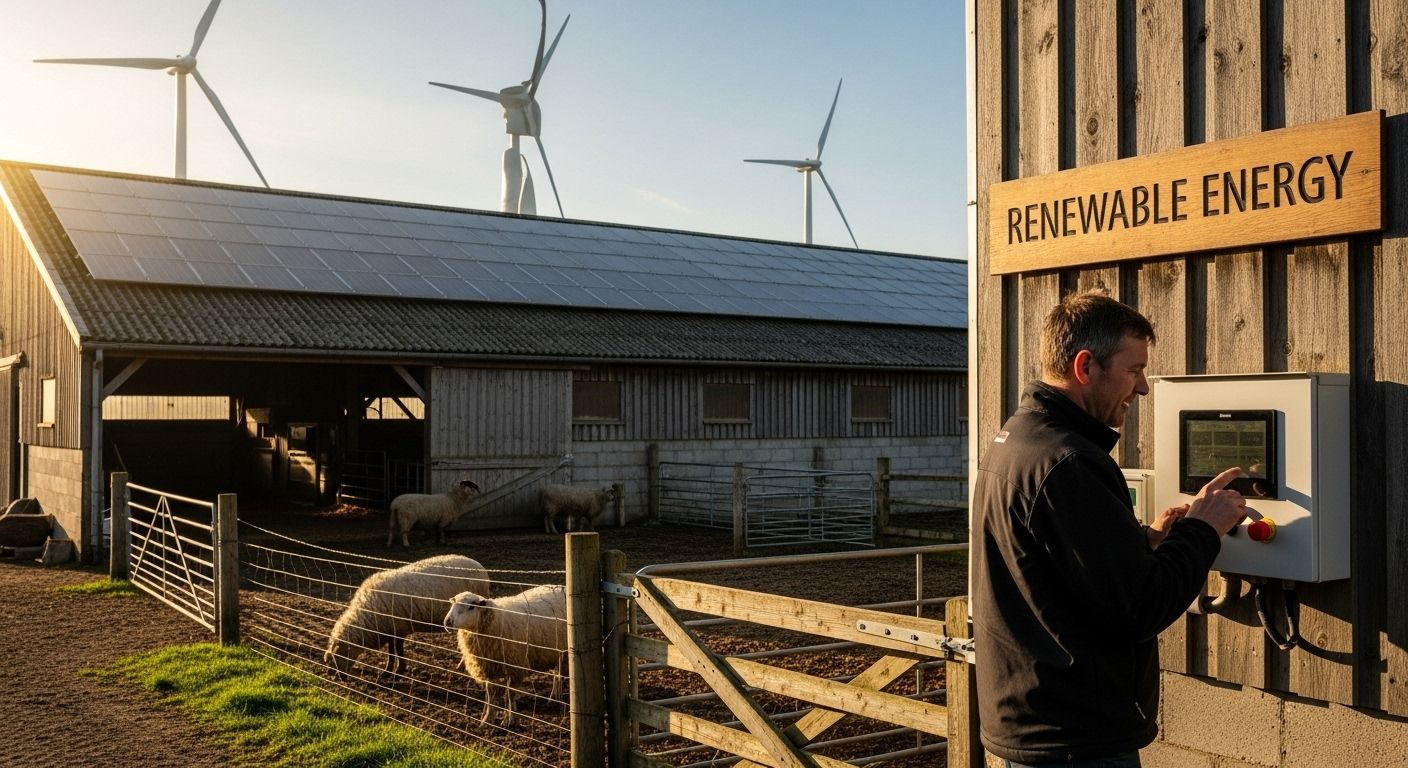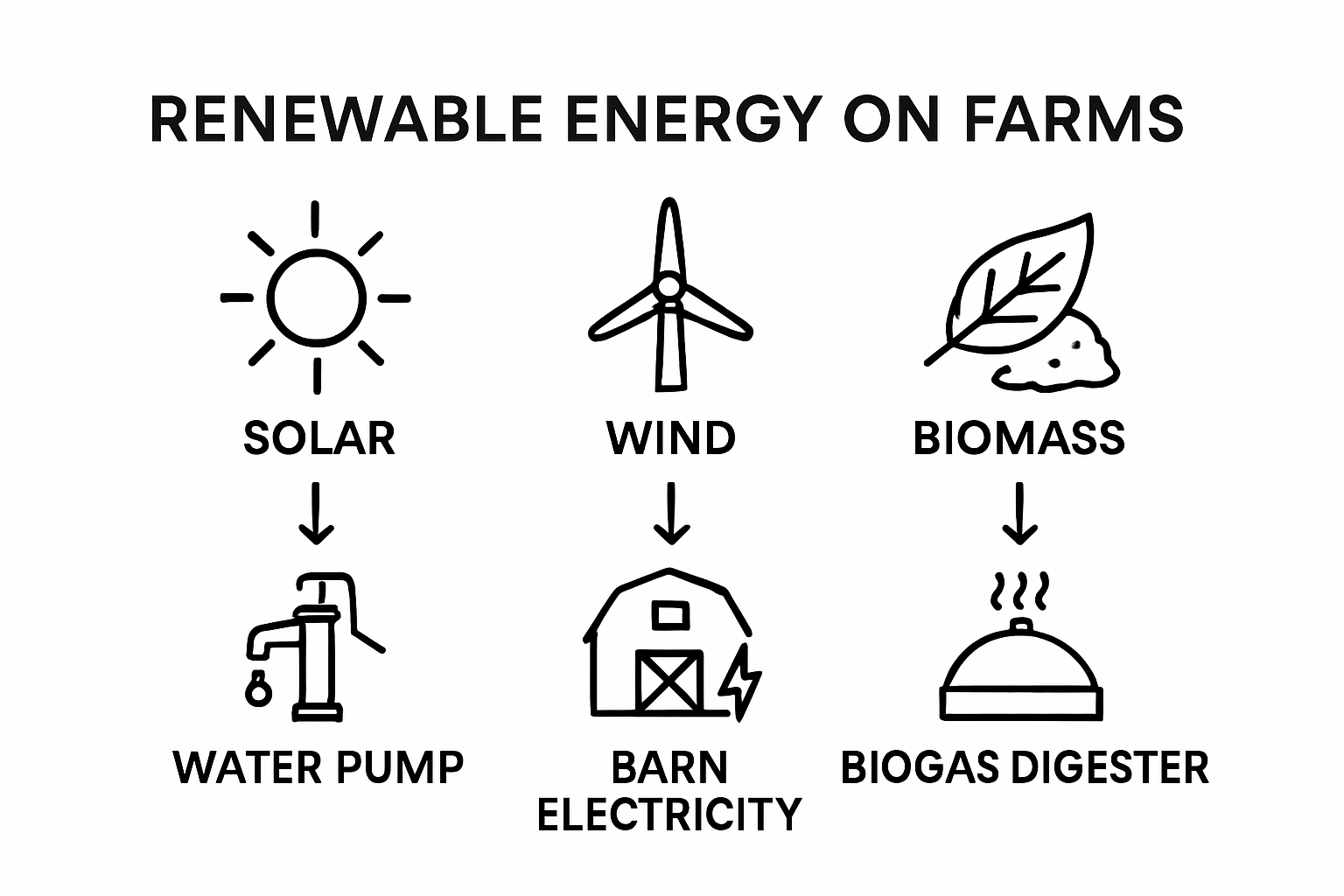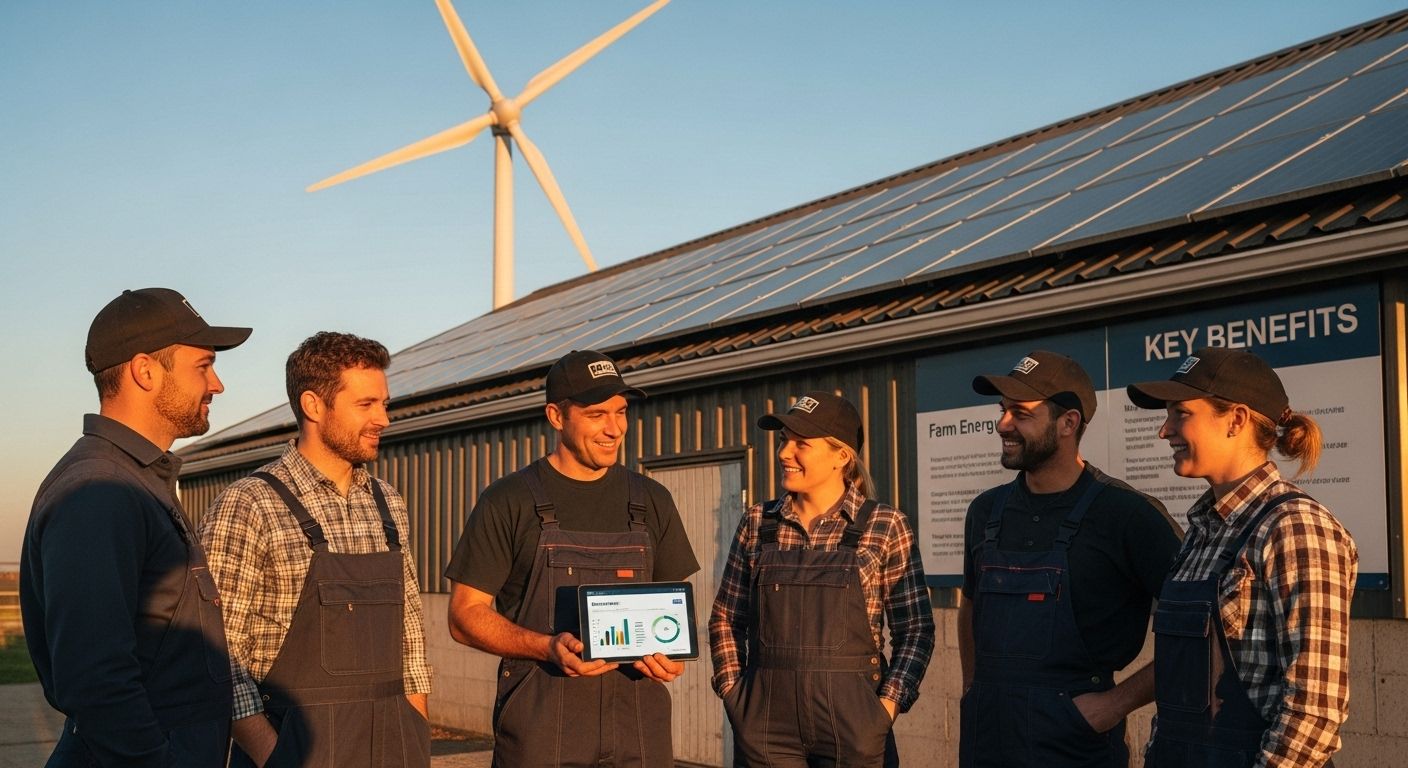
Farmers are making a big shift as renewable energy changes the way fields and barns stay powered across the country. Nearly 10 percent of US farms now use some form of renewable energy, a number that keeps growing every year. It sounds like a futuristic upgrade just for tech-savvy businesses, but the real story goes much deeper. Small family farms are now running their irrigation, lighting, and even livestock shelters with solar and wind, sometimes in places the electric grid barely reaches at all.
Table of Contents
- What Is Renewable Energy And Its Types?
- Why Renewable Energy Matters For Farming
- How Renewable Energy Systems Work On Farms
- Key Benefits Of Implementing Renewable Energy
- Real-World Applications Of Renewable Energy In Agriculture
Quick Summary
| Takeaway | Explanation |
|---|---|
| Invest in Solar and Wind Energy | These technologies reduce energy costs and support agricultural operations efficiently. |
| Utilize Biomass for Energy | Convert agricultural waste into energy, lowering disposal costs and maximizing efficiency. |
| Explore Government Incentives | Financial benefits such as tax credits can enhance economic viability for farms embracing renewables. |
| Implement Smart Energy Management | Advanced systems optimize energy production and consumption, enhancing operational efficiency. |
| Adopt Agrivoltaics | Combining solar panels with crop production can increase yields while providing renewable energy. |
What is Renewable Energy and Its Types?
Renewable energy represents a transformative approach to power generation that harnesses naturally replenishing resources without depleting environmental reserves. Unlike traditional fossil fuels, renewable energy sources continuously regenerate, offering sustainable alternatives for agricultural operations and rural communities.
Understanding Renewable Energy Fundamentals
Renewable energy is power generated from sources that naturally restore themselves within human timescales. According to the U.S. Department of Energy, these sources include solar, wind, geothermal, hydropower, and biomass energy systems. For farmers and agricultural professionals, renewable energy presents an opportunity to reduce operational costs while minimizing environmental impact.
Key characteristics of renewable energy include:
- Sustainable and continuously replenished
- Low carbon emissions
- Minimal environmental degradation
- Potential for local energy production
Primary Types of Renewable Energy
Farmers can leverage multiple renewable energy types depending on their geographical location, resources, and specific agricultural needs:
Solar Energy: Photovoltaic panels convert sunlight directly into electricity, making it an excellent option for rural properties with significant sun exposure. Solar installations can power irrigation systems, livestock facilities, and farm equipment.
Wind Energy: Wind turbines transform kinetic wind energy into electrical power. Rural landscapes with consistent wind patterns are ideal for small to medium wind energy systems that can supplement or replace traditional grid electricity.
Biomass Energy: This renewable energy type utilizes organic materials like crop residues, animal waste, and agricultural byproducts to generate heat and electricity. Biomass systems provide farmers a way to convert waste into valuable energy while reducing disposal costs.
By understanding and implementing renewable energy solutions, farmers can create more resilient, cost-effective, and environmentally responsible agricultural operations. The transition towards renewable energy represents not just an ecological choice, but a strategic investment in long-term agricultural sustainability.
To help clarify the main renewable energy options available for farms, this table summarizes the key types and their primary features as covered in the article.
| Renewable Energy Type | Description | Typical Farm Applications |
|---|---|---|
| Solar Energy | Converts sunlight into electricity using photovoltaic panels | Powers irrigation, lighting, livestock shelters, and equipment |
| Wind Energy | Utilizes wind turbines to generate electrical power | Supplements or replaces grid electricity in windy rural areas |
| Biomass Energy | Uses organic materials like crop residues and animal waste to create energy | Provides heating and electricity; reduces waste disposal costs |

Why Renewable Energy Matters for Farming
Renewable energy is not just an environmental trend but a strategic necessity for modern agricultural operations. Farmers are increasingly recognizing the critical role sustainable energy sources play in creating resilient, economically viable, and environmentally responsible agricultural systems.
Economic Benefits of Renewable Energy
According to the National Renewable Energy Laboratory, renewable energy integration offers substantial economic advantages for farming communities. These energy solutions provide multiple financial benefits that extend beyond traditional power generation:
- Reduced operational energy costs
- Additional income through energy production
- Lower dependence on fluctuating fossil fuel prices
- Potential for government incentives and tax credits
Cost Savings: By generating their own electricity through solar panels, wind turbines, or biomass systems, farmers can significantly reduce monthly utility expenses. This direct cost reduction translates into improved profit margins and increased financial stability for agricultural businesses.
Environmental and Operational Advantages
Renewable energy technologies offer farmers more than just economic benefits. They provide critical environmental and operational improvements that enhance overall agricultural sustainability.
Resource Efficiency: Renewable energy systems allow farmers to transform agricultural waste into productive energy. Biomass solutions can convert crop residues, animal manure, and other organic materials into electricity and heat, creating a closed-loop system that minimizes waste and maximizes resource utilization.
Climate Resilience: As climate change impacts agricultural productivity, renewable energy offers a pathway to more adaptable farming practices. Solar and wind installations can provide reliable power during extreme weather events, ensuring continuous operation of critical farm infrastructure like irrigation systems, livestock management equipment, and storage facilities.
By embracing renewable energy, farmers are not just adopting new technologies but investing in a more sustainable, economically robust agricultural future. These solutions represent a forward-thinking approach that balances environmental stewardship with economic pragmatism, positioning farmers at the forefront of sustainable innovation.
The following table outlines the primary benefits of renewable energy for farms, organizing the economic, environmental, and operational advantages highlighted in the article.
| Benefit Category | Specific Advantages |
|---|---|
| Economic | Reduced energy costs, income through energy production, tax credits, less reliance on fossil fuel prices |
| Environmental | Low carbon emissions, use of waste for energy, improved resource efficiency, reduced environmental impact |
| Operational | Reliable power supply, climate resilience, independent from grid, continuous operation of farm systems |
How Renewable Energy Systems Work on Farms
Renewable energy systems transform natural resources into usable power through sophisticated yet reliable technologies specifically adaptable to agricultural environments. Understanding the mechanics behind these systems helps farmers make informed decisions about implementing sustainable energy solutions.
Solar Energy Conversion Mechanisms
Photovoltaic Technology: Solar panels operate by capturing sunlight through semiconductor materials, typically silicon, which generate electrical currents when exposed to solar radiation. According to the National Renewable Energy Laboratory, farm solar installations can be ground-mounted or integrated directly onto existing structures like barn roofs, barns, and equipment storage facilities.
Key solar energy system components include:
- Photovoltaic panels
- Inverter systems
- Battery storage units
- Electrical connection infrastructure
Wind and Biomass Energy Generation
Wind Turbine Functionality: Wind energy systems convert kinetic wind movement into electrical power through rotating blades connected to generators. For agricultural settings, smaller turbines ranging from 10 to 100 kilowatts can effectively supplement farm energy requirements, providing consistent power with minimal maintenance.
Biomass Energy Production: Biomass systems convert organic agricultural waste into usable energy through thermal or biochemical processes. Farmers can transform crop residues, animal manure, and agricultural byproducts into electricity and heat through:
- Anaerobic digestion
- Direct combustion
- Gasification techniques
Integration and Energy Management
Successful renewable energy implementation requires comprehensive system integration. Modern farm renewable energy solutions incorporate smart monitoring technologies that optimize energy production, storage, and distribution. Advanced inverters and management systems allow farmers to track energy generation, consumption, and potential grid feedback in real time.
By understanding these technological mechanisms, farmers can strategically design renewable energy systems tailored to their specific operational needs, transforming agricultural energy consumption from a cost center to a potential revenue stream.
Key Benefits of Implementing Renewable Energy
Renewable energy represents more than an environmental solution for farmers it is a strategic approach to enhancing agricultural productivity, financial stability, and operational resilience. By integrating sustainable energy technologies, agricultural operations can unlock multiple advantages that extend far beyond traditional energy consumption models.
Financial and Economic Advantages
According to the U.S. Department of Agriculture Climate Hubs, implementing renewable energy offers substantial economic benefits for agricultural operations. These financial advantages create new opportunities for farm sustainability and profitability:
- Reduced energy operational costs
- Additional income through energy production
- Potential tax credits and government incentives
- Decreased dependence on volatile fossil fuel markets
Cost Stabilization: Renewable energy systems provide farmers with predictable energy expenses, protecting against fluctuating utility rates and fuel prices. By generating their own electricity, farmers can create a more stable financial environment for long-term planning and investment.
Environmental and Operational Benefits
Crop and Ecosystem Enhancement: Innovative approaches like agrivoltaics demonstrate how renewable energy can directly improve agricultural productivity. Solar panels installed over crop areas can:
- Provide protective shade for sensitive plants
- Reduce water evaporation
- Moderate local microclimate conditions
- Create additional land use opportunities
Climate Resilience: Renewable energy systems enhance farm adaptability during extreme weather events. Decentralized power generation ensures continuous operation of critical infrastructure like irrigation systems, livestock management equipment, and storage facilities, even during grid disruptions.
Long-Term Strategic Advantages
Beyond immediate benefits, renewable energy positioning farmers as forward-thinking innovators in sustainable agriculture. By reducing carbon footprints and demonstrating environmental stewardship, farmers can access emerging markets, attract environmentally conscious consumers, and contribute to broader climate change mitigation efforts.
The transition to renewable energy is not just a technological upgrade but a comprehensive strategy for creating more resilient, efficient, and economically viable agricultural operations. Farmers who embrace these solutions position themselves at the forefront of agricultural innovation, balancing economic pragmatism with environmental responsibility.

Real-World Applications of Renewable Energy in Agriculture
Renewable energy technologies are transforming agricultural operations by providing practical, innovative solutions that address multiple farm management challenges. These technologies go beyond theoretical concepts, offering tangible benefits across various agricultural sectors and farm sizes.
Irrigation and Water Management
According to the Agricultural Sustainability Institute, solar-powered irrigation systems represent one of the most impactful renewable energy applications in modern farming. These systems leverage photovoltaic technology to power water pumps, creating sustainable and cost-effective irrigation solutions for diverse agricultural landscapes.
Key advantages of solar irrigation include:
- Reduced electricity costs
- Independence from grid infrastructure
- Consistent water supply during daylight hours
- Minimal maintenance requirements
Remote Area Solutions: Solar irrigation proves especially beneficial in regions with limited electrical infrastructure, enabling farmers to establish productive agricultural operations in previously challenging locations.
Livestock and Farm Infrastructure
Renewable Energy for Animal Facilities: Modern farms are integrating renewable energy systems to power livestock management infrastructure. Wind and solar technologies can provide electricity for:
- Barn lighting and ventilation
- Automated feeding systems
- Electric fencing
- Temperature control mechanisms
Waste-to-Energy Conversion: Biomass systems allow farmers to transform animal waste into electricity and heat, creating a closed-loop energy solution that reduces waste management costs while generating renewable power.
Precision Agriculture and Monitoring
Renewable energy technologies are becoming integral to advanced agricultural monitoring and precision farming techniques. Solar-powered sensors and monitoring stations enable farmers to collect real-time data on crop conditions, soil moisture, and environmental parameters without relying on traditional power sources.
By embracing these innovative applications, farmers demonstrate how renewable energy is not just an environmental strategy but a practical approach to enhancing agricultural productivity, efficiency, and sustainability. The integration of renewable technologies represents a forward-thinking approach to modern agricultural management.
Take Your Farm’s Renewable Energy Further with Practical Solutions
Are you ready to unlock the full benefits of renewable energy on your farm, but worry that your current infrastructure for fencing and animal management could hold you back? Many farmers face the challenge of making their operations more sustainable while still ensuring animal safety and reliable power for everyday needs. The article you just read highlights how integrating solar, wind, and smart management tools can transform not only your energy usage, but your entire agricultural workflow.

Now is the perfect time to bridge what you have learned with proven solutions. Explore how FenceFast.ca supports your renewable energy journey with electric fencing systems, solar panel-powered gates, and animal management tools that integrate smoothly with modern, energy-efficient farms. Whether you are looking to set up dependable electric fencing or invest in solar accessories for remote livestock areas, let us help you maximize your operation’s resilience and sustainability. Visit us today and see how your farm can thrive in a cleaner, smarter future.
Frequently Asked Questions
What are the main types of renewable energy suitable for farms?
Farmers can utilize various renewable energy types, including solar energy, wind energy, biomass energy, geothermal energy, and hydropower, depending on their location and resources.
How do solar panels work in agricultural settings?
Solar panels convert sunlight into electricity using photovoltaic technology, making them suitable for powering irrigation systems, livestock facilities, and farm equipment. They can be ground-mounted or installed on existing structures such as barns.
What are the economic benefits of implementing renewable energy on farms?
Implementing renewable energy can lead to reduced operational costs, additional income from energy production, lower dependence on fluctuating fossil fuel prices, and potential government incentives or tax credits.
How can biomass energy systems benefit agricultural operations?
Biomass energy systems convert organic materials, such as crop residues and animal waste, into usable energy. This process reduces waste disposal costs and provides a sustainable energy source for heating and electricity on farms.
Recommended
-
[
Gate Wheel – FenceFast Ltd.
-
[
Gallagher Wide Jaw Wood Post Insulator 25/Bag – FenceFast Ltd.
](https://fencefast.ca/products/gallagher-super-w-wood-post-insulator)
-
[
EZG 9 cu ft Mobile Mud Hog – FenceFast Ltd.
](https://fencefast.ca/products/new-ezg-9-cu-ft-mobile-mud-hog)
-
[
Plastic Drum with Lid - 15 Gallon, Open Top, Blue – FenceFast Ltd.
](https://fencefast.ca/products/plastic-drum-with-lid-15-gallon-open-top-blue)
